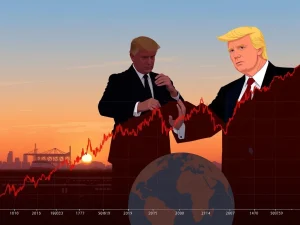Bitcoin Price Faces Critical Threat from 2-Month Tariff Trap: Analyst

For anyone tracking the cryptocurrency space, understanding the factors that influence the Bitcoin price is crucial. A recent analysis highlights a significant potential roadblock for bulls, stemming not directly from crypto fundamentals, but from broader macroeconomic policy. According to one analyst, the biggest threat to bullish sentiment over the next two months lies in the ongoing uncertainty surrounding US tariffs.
The Critical Threat to Bitcoin Price: Tariff Uncertainty
The persistent back-and-forth regarding US tariffs poses the most significant risk for investors betting on Bitcoin in the near term. Pav Hundal, lead analyst at Swyftx, suggests that the primary danger is a continuation of the current situation, where the market remains stuck in a cycle of tariff ultimatums without resolution.
Hundal stated, “The biggest threat to bulls right now is that nothing changes over the next two months, and we just stay trapped in this cycle of endless tariff ultimatums.”
How US Tariffs Impact the Crypto Market
The analyst explains that this tariff uncertainty could lead US policymakers to delay crucial monetary easing decisions. They might wait for “hard data” on the impact of these tariffs, risking a potential growth slowdown. This cautious approach from policymakers casts a shadow over risk-on assets, including the broader crypto market analysis.
Historical context shows the sensitivity of Bitcoin to tariff news. When tariff issues were initially raised earlier in the year, the Bitcoin price dropped below $100,000 and remained volatile. While a court recently blocked some proposed tariffs, the administration has also doubled tariffs on certain imports, illustrating the unpredictable nature of the situation.
Federal Reserve Policy and the Bitcoin Forecast
The uncertainty created by tariffs complicates the picture for the Federal Reserve. The Fed recently held interest rates steady, balancing risks of rising unemployment and inflation. Hundal notes that the tariff situation makes achieving the previously targeted 2% inflation goal look less certain. He describes the US economic situation as being at a “macro crossroads,” with the Fed navigating a difficult path.
A prolonged period of uncertainty could negatively impact market sentiment. If bears gain traction due to this macroeconomic cloud, Hundal warns that the Bitcoin price could potentially drop back below the $100,000 level.
Potential Scenarios: Below $100k or Towards $120k?
While the tariff trap presents a risk, an end to the uncertainty could pave the way for significant upside. Hundal believes that if the “tariff sabre rattling” ceases, it would create a “glide path” for Bitcoin to potentially reach $120,000 as early as June.
This aligns with other expert predictions. Analysts at Bitfinex have suggested a potential surge towards new all-time highs above $115,000 in July. Their Bitcoin forecast is partly contingent on continued institutional buying and weaker-than-expected US job data, which could encourage the Federal Reserve to consider earlier interest rate reductions – a bullish signal for Bitcoin.
Expert Insights on Bitcoin Price Movements
Understanding these macro factors is key to interpreting potential Bitcoin price movements. The analyst consensus points to the tariff situation and the subsequent reaction from the Federal Reserve as critical variables influencing the short-to-medium term Bitcoin forecast. The coming months will be telling for how these external economic pressures interact with the inherent dynamics of the crypto market analysis.
In summary, while internal market factors are always at play, external macroeconomic forces, particularly the uncertainty surrounding US tariffs and the Federal Reserve’s response, pose a significant threat to the current bullish trajectory of the Bitcoin price. However, a resolution could also unlock substantial upside potential, according to analysts providing crypto market analysis.








